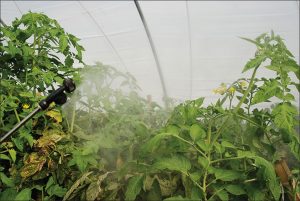One of the hardest working tools for vegetable and small fruit growers are our backpack sprayers. Using them to their fullest will undoubtedly make for better produce through less weed pressure and greater insect, mite and disease management. Here are some tips for using these workhorses to their fullest and avoiding potential problems.
- Have separate sprayers for herbicides. There is no problem in using the same sprayer for insecticides, miticides, fungicides, bactericides and foliar nutrients, but many herbicides are extremely hard to completely remove from sprayers. In many cases low levels measured in parts per million, or even parts per billion, of herbicide residue can do serious harm to sensitive plants like tomatoes. Mark your sprayers well with a weather and solvent resistant marker and remark them as the lettering wears over time. Make sure everyone on your team understands how important keeping these separated is to your success.
- Consider powered sprayers. Hand pumped backpacks are inexpensive and work well when just doing a tank or two, but they get to be a real workout when the weather is hot and humid, and you’ve got multiple tanks to apply. Rechargeable battery powered backpacks are light and provide even application over many tanks keeping the operator fresh.
-

Spray pattern and volume at 150 psi, note how the upper part of the tomato plant in the upper right is being blown backwards. Check the Specifications of the battery-powered sprayers as they vary widely. Low pressure (below 60 psi) is fine for herbicide applications, but higher pressure, thus finer droplet size, makes a huge difference in managing insects, mites and disease. One good choice is a Dramm BP-4 sprayer that developers up to 150 psi (images show difference between a 42 psi and 150 psi spray stream). Finer droplets at higher pressure can directly translate into better coverage on the lower surfaces of leaves which is where many problems get their start. Gasoline backpacks are great for insect and disease control, but make sure to ventilate your greenhouse or tunnel well during and after application to reduce fuel fumes.
-

Spray pattern at 42 psi. Select your nozzle carefully. Adjustable cone nozzles come with many sprayers and are great multi-use applicators. However, flat tips are often superior when applying herbicides over large areas or covering lots of leaf area evenly. The dual tips that are shipped with the BP-4 (noted above) produce an impressive ‘tornado’ effect that does a great job covering a lot of crop quickly and evenly with good lower leaf deposition.
- Clean your sprayer well immediately after use. This is important and a practice that often gets overlooked on a busy farm. Many materials can clog sprayer pumps and screens if left uncleaned at the end of use. Six ounces of liquid ammonia left in a tank for at least an hour will remove most deposits. (Rinse the tank well three times after use, push some clean water through the lines and nozzle(s), clean the nozzle screens, then fill with water and ammonia and let sit. Drain, then flush with clean water and the sprayer is ready to use or store. There are also commercial tank cleaners, and it should probably be mentioned that any of our plant foods are extremely effective at cleaning chemical residues from poly or plastic spray tanks. There have been several instances where this has been a problem with larger and older agricultural spray equipment.)
- Keep the fill screen/strainer basket in place. It’s there for a reason and will be valuable for avoiding clogged nozzle tips.
- Take the time to calibrate your sprayer(s). There are many ways to do this, but in general, you will be filling the sprayer with a known amount of water and seeing how far it goes, then doing the math for a full application. Everyone carries their sprayer wand differently and walks at different speeds, so it’s worth the time to get this right. Here again, a powered sprayer eliminates the variable of the pressure changing during application. Certain materials such as glyphosate, foliar nutrients (ISP plant foods, silicon, biostimulants), and insecticidal soaps (Insect-X-Citer) rates are based on percentage of, or amount of material in solution. This eliminates the calibration step as the operator only needs to watch for good coverage.
- Use the right PPE. Rubber boots, rubber gloves and goggles are a must as it is nearly impossible to do a good application without getting some material on you. Read the label(s) carefully and follow the recommendations for using the right protective equipment. When working in tight conditions such as a greenhouse or tunnel, a Tyvek suit will keep just applied surfaces from soaking skin. Thin plastic raincoats are also excellent for keeping tank solution from getting on you.
- Winter / off-season care. As growers, we often tend to think more about repairs and maintenance to tractors and related equipment. Taking the time to go over every backpack in preparation for the next season will make for an easier spring when we begin using our sprayers again. Most manufacturers have good information for getting parts. Replacing hand grips, shoulder straps and looking for other wear areas will go a long way to reducing startup frustrations. Gasoline backpacks should either be drained, run until empty, or have fuel stabilizer added to their tanks per the manufacturers recommendations.
SUMMATION – Take care of your backpack. Use the right backpack for the job. Have dedicated backpacks for herbicides only. Clean your backpack well between uses and storage, and replace parts as needed. This is a valuable tool and should give you years of service.
